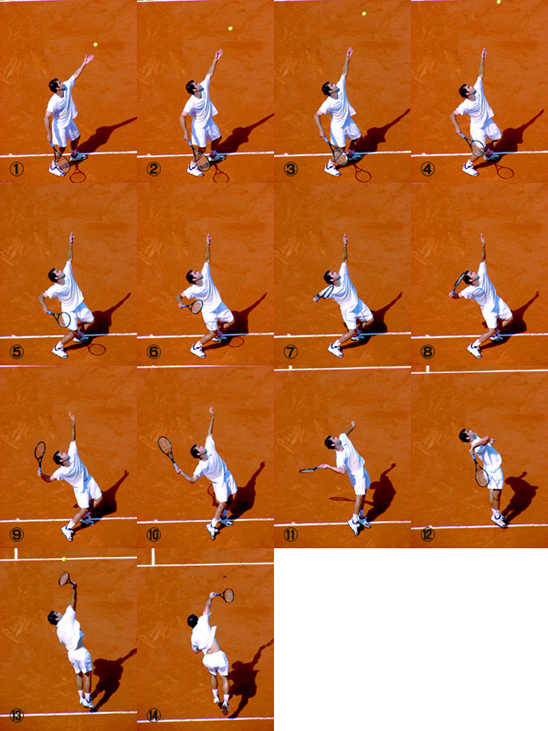=sportsfan1;6431740]Thanks for this explanation!
1) "backscratch racquet drop should be to the right side instead of middle of the back" : Exactly, I am doing this wrong. I need to change to the right side.
Not only is the racquet well to the right side to set up pronation, all the pros set up the later pronation movement by supinating at the deepest racquet drop. So in that sequence of Stosur serving, in pic 1 she has supinated so that you can see the full stringbed as a sign of that supination - if she had just reached full racquet drop without supinating, the string bed would be harder to see - as it is harder to see in pics 7, 8, 9 where the supination has reverted to a neutral phase, so that rather than seeing the wide expanse of string bed, you see just the edge of the frame.
You can see the same supination in the Sampras racquet drop in pic 12:
(As well as clear alignment of the racquet along the right side of the body - no back scratch in the middle of the back here.)
Most consider supinating at racquet drop to be an "advanced" technique.
But supinating at maximum racquet drop sets up a "feeling of tension" that cannot be sustained as you start to "throw the butt of the racquet at the ball" - you've already started to pronate as you go from supinated to neutral.
And that makes it easier to continue from neutral to pronation.
You may want to try this - supinating in the racquet drop - to see if it helps you to subsequently pronate.
2) "Initial move up from deepest backscratch is pulling your racquet butt straight up at the ball": I was trying to visualize the 'L' shape and watching the edge of the racquet to the ball, but stuff happens so fast that it's impossible to watch. Thinking about pulling the racquet butt at the ball sounds more promising.
Just about everyone has heard about "hitting up the mountain"
http://www.youtube.com/watch?v=WlPVdppfYGs
Well "hitting up the mountain" means directing the body and the arm in an upward direction.
Yet many stick to the preconceived notion that they have to hit the ball forward (rather than up) - so they start to direct the racquet forward way too early.
But that photo sequence of Stosur shows how she "pulls the butt of the racquet straight up at the ball"and fully extends her elbow before much of the pronation right to left "slap" occurs.
Looking at it from the side, you can actually see that the racquet is not pulled
perfectly straight up:
But in pics 4-6 the racquet butt is
essentially pulled up at the ball, with the small forward deviation a consequence that the shoulder angle has gone from front shoulder up in pic 4, to front shoulder down in pic 5, and more down in pic 6.
And you are certainly right that the racquet speed during pronation is such a blurr that the mechanism can only be captured with high speed video, verry fast shutter speeds, or strobe photography:
3) I am trying to learn to complete pronation with the butt cap pointing to sky as Coach McCraw shows (with a ball resting on the butt cap), or "inverted U" as FYB puts it, or as shown in the Sampras video at 2:58 (
http://www.youtube.com/watch?v=4DpptgXq5j4&t=2m58s). I have done the drill to pronate and trap the ball against the wall to get pronation feel, however the complete action with butt cap pointing to the sky remains very elusive

. I should try McCraw's drill) - this looks more complex to nail down than other parts of the serve. Any idea on how many repetitions of the drill on average it takes to learn this?
Ash has already answered this - we're lucky to have such an experienced tennis pro comment.
But if you can get a "feel" of what pronation feels like from Coach Mcraw's drill, it should subsequently be easier to add pronation into your service motion. (And don't be too worried if your racquet is not as fully inverted as McCraw's or Sampras's - they are pros who have been doing this a long time. Indeed, striving too hard could hurt your shoulder.)
But because you also have to "unlearn" you previous "muscle memory" of how you used to serve, consider doing the serve motion even in your back yard without a ball to try and at least get the "feeling" of the full service motion before trying to add it in along with a ball toss from the service line at the court.
The next step may be to hit serves just into the back fence with your whole new motion, rather than getting frustrated by trying to get your serves in from the service line. (Indeed, it is all too easy to revert back to your old motion by stepping up to the service line and trying to get your serves in too soon.)
You would be a most unusual athlete if this all comes very easily.
But ... good luck! You'll get there!
















